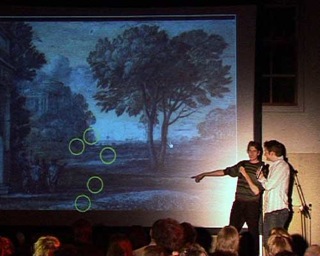eyetrack
Presentation at FLOSSSense
24-11-06 22:54

Eye-gaze based interest awareness
11-12-06 21:05
In many situations, the amount of information that can be given to a receiving party exceeds practical constraints such as the time available for the information exchange, motivational limitation on the receiving party, or the maximum complexity that the receiving party is willing to process. A typical example of this situation is a professional, educated museum guide touring an interested party of art novices through a museum. The guide has access to much more knowledge that the party can handle, so she has to limit the information given during the tour. Based on the perceived interests of the party, the guide can adapt her tour, selecting from her extensive knowledge of the works exhibited in the museum, to better align the relayed information to the interests of the party.
This project will address the question of how to use eye-tracking data in extracting the interests of a user from her eye movements. In a previous project (described by Janssen, 2006; Van Maanen, Janssen, & Van Rijn, 2006), we built a Virtual Museum Guide (VMG) that commented on the presented art works based on the eye fixations of the visitor. The VMG only gave background information on the depicted objects or persons if users fixated on them.
However, from the eye movements literature it is known that people do not have voluntary control over their eye movements (Theeuwes, 1992). Usually, control of eye-movements is divided into a voluntary component and a stimulus-driven component (Henderson, 2003). That is, eye movements can be caused by salient features of the art works. In this project, we will adapt the existing Virtual Museum Guide to discount for the involuntary eye movements.
References:
People involved in this project:
This project will address the question of how to use eye-tracking data in extracting the interests of a user from her eye movements. In a previous project (described by Janssen, 2006; Van Maanen, Janssen, & Van Rijn, 2006), we built a Virtual Museum Guide (VMG) that commented on the presented art works based on the eye fixations of the visitor. The VMG only gave background information on the depicted objects or persons if users fixated on them.
However, from the eye movements literature it is known that people do not have voluntary control over their eye movements (Theeuwes, 1992). Usually, control of eye-movements is divided into a voluntary component and a stimulus-driven component (Henderson, 2003). That is, eye movements can be caused by salient features of the art works. In this project, we will adapt the existing Virtual Museum Guide to discount for the involuntary eye movements.
References:
- Henderson, J. M. (2003). Human gaze control during real-world scene perception. Trends in Cognitive Sciences, 7(11), 498-504.
- Itti, L., Koch, C., & Niebur, E. (1998). A model of saliency-based visual attention for rapid scene analysis. IEEE Transactions on Pattern Analysis and Machine Intelligence, 20(11), 1254-1259.
- Janssen, C. (2006). The virtual museum tour guide: An eye-fixation based recommender system. Unpublished BSc thesis, Groningen, Groningen.
- Theeuwes, J. (1992). Perceptual selectivity for color and form. Perception & Psychophysics, 51(6), 599-606.
- Van Maanen, L., Janssen, C., & Van Rijn, H. (2006). Personalization of a virtual museum guide using eye-gaze, proceedings of CogSci'06 (pp. 2620). Vancouver, BC.
People involved in this project:
- Chris Janssen
- Leendert van Maanen
- Hedderik van Rijn
